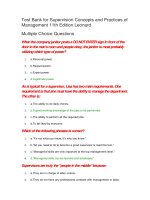Test bank business ethics concepts and cases chapter 51
Bạn đang xem bản rút gọn của tài liệu. Xem và tải ngay bản đầy đủ của tài liệu tại đây (83.71 KB, 4 trang )
1.
What is the distinction (or the relationship) between pollution and resource depletion?
2.
Environmental damage inevitably threatens the welfare of human beings as well as plants
and animals. Threats to the environment come from two sources: pollution and resource
depletion.
a.
True
b.
False
3.
The undesirable and unintended contamination of the environment by the manufacture or
use of commodities is commonly referred to as:
a.
Resource depletion.
b.
Pollution.
c.
Degradation.
d.
Contamination.
4.
What are the most important types of air pollution? What harmful effects does each form
have on our lives, health, and economic well-being?
5.
What are the main sources and types of land and water pollution? What dangers do these
types of pollution represent?
6.
_____________ refers to the consumption of finite or scarce resources.
a.
Resource depletion
b.
Pollution
c.
Degradation
d.
Contamination
7.
The release of CFCs into the atmosphere may lead to several hundred thousand new cases
of skin cancer each year and destroy many valuable food crops. Also, ocean plankton–on
which the entire ocean's food chain depends–may be severely damaged. This is referred
to as:
a.
Resource depletion.
b.
Ozone depletion.
c.
Environment depletion.
d.
Contamination continuance.
8.
What is exponential depletion of resources? What is peaked depletion of resources?
What are the economic consequences of both models?
9.
How do the concepts of "unlimited good" and "carrying capacity" relate to pollution
control?
10.
Acid rain is caused by:
a.
Global warming.
b.
Fossil fuels.
c.
Airborne toxins.
d.
None of the above.
11.
Because our environment is so complex and its parts are so interwoven, many theorists
believe that our duty to protect the environment extends beyond the welfare of humans to
other nonhuman parts of the system. This idea is called:
a.
Ecological ethics or deep ecology.
b.
Conservation ethics.
c.
Survival ethics.
d.
None of the above
12.
Define deep ecology or ecological ethics. What are the consequences of taking an ecological ethic
seriously?
13.
What is Blackstone's concept of environmental rights? What are the weaknesses of his
theory? Are there any ways to answer these concerns?
14.
Few views of deep ecology are unusual and/or controversial.
a.
True
b.
False
15.
The saving or rationing of natural resources for later use is referred to as:
a.
Evolution.
b.
Ecology.
c.
Planned deletion.
d.
Conservation.
16.
What is the difference between private costs and social costs? Why is it a problem when
they diverge? What remedies for this divergence are there?
17.
How are cost-benefit analyses related to pollution control? What are the limitations
inherent in such analyses? How does informed consent enter into the issue?
18.
We cannot rely on market mechanisms to ensure adequate conservation for future
generations, however. The needs of future generations are so heavily discounted by
markets that they hardly affect prices at all.
a.
True
b.
False
19.
The Green Valley is estimated to have enough natural gas to support the nation for an
entire year.
a.
True
b.
False
20.
How do social ecology and ecofeminism attempt to rethink standard approaches to the
environment? What are the values and limitations of these views?
21.
What considerations are relevant for the ethics of conserving depletable resources? Do
future generations have the same right to the earth's resources as we do? Do other
countries have the same claim to resources, such as energy, as we do?
22.
The gas field known as the Pinedale Anticline is expected to stop the energy boom.
a.
True
b.
False
23.
The oil wells are not expected to disrupt the sensitive economic system in the Valley's
Basin.
a.
True
b.
False
24.
What are the prospects for continued economic growth? What ethical problems pertain to
continual growth?
25.
Each human generates ________ of garbage each day.
a.
45 pounds
b.
14.5 pounds
c.
4.5 pounds
d.
None of the above
26.
The hole in the stratospheric ozone layer over the Antarctic expected to not recover until
sometime between the years 2060 to 2075.
a.
True
b.
False
27.
BHP had a tailings containment plan study prepared to deal with the OK Tedi Copper Mine
river pollution. Of the following approaches, which one was the least total likely cost.
a.
Mine and dredge
b.
Mine only
c.
Mine and dredge and store
d.
Early closure
Test Name: chapter 5
1.
2.
3.
4.
5.
6.
7.
8.
9.
10.
11.
12.
13.
14.
15.
16.
17.
18.
19.
20.
21.
22.
23.
24.
25.
26.
27.
a.True
b.Pollution.
a.Resource depletion
b.Ozone depletion.
b.Fossil fuels.
a.Ecological ethics or deep ecology.
a.True
d.Conservation.
a.True
a.True
b.False
b.False
c.4.5 pounds
a.True
b.Mine only









